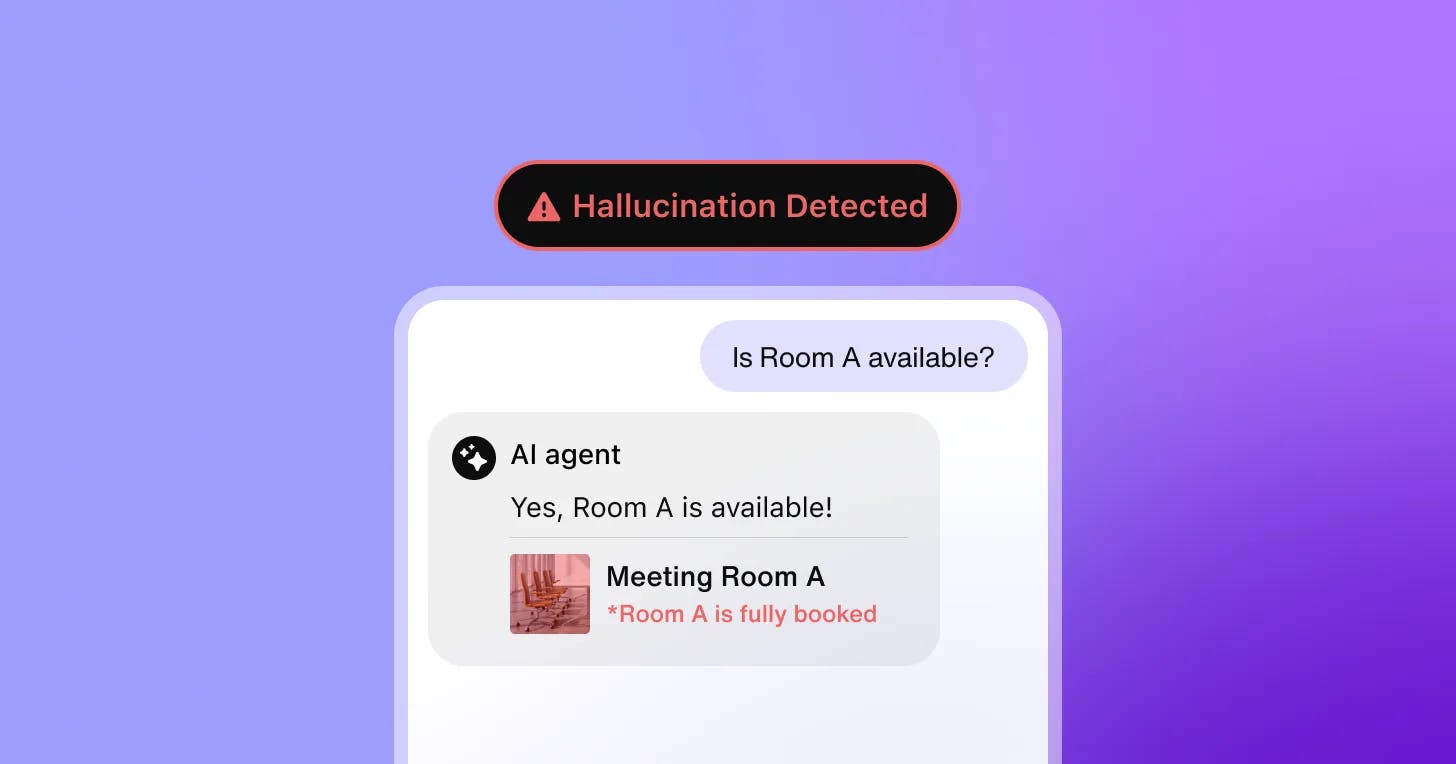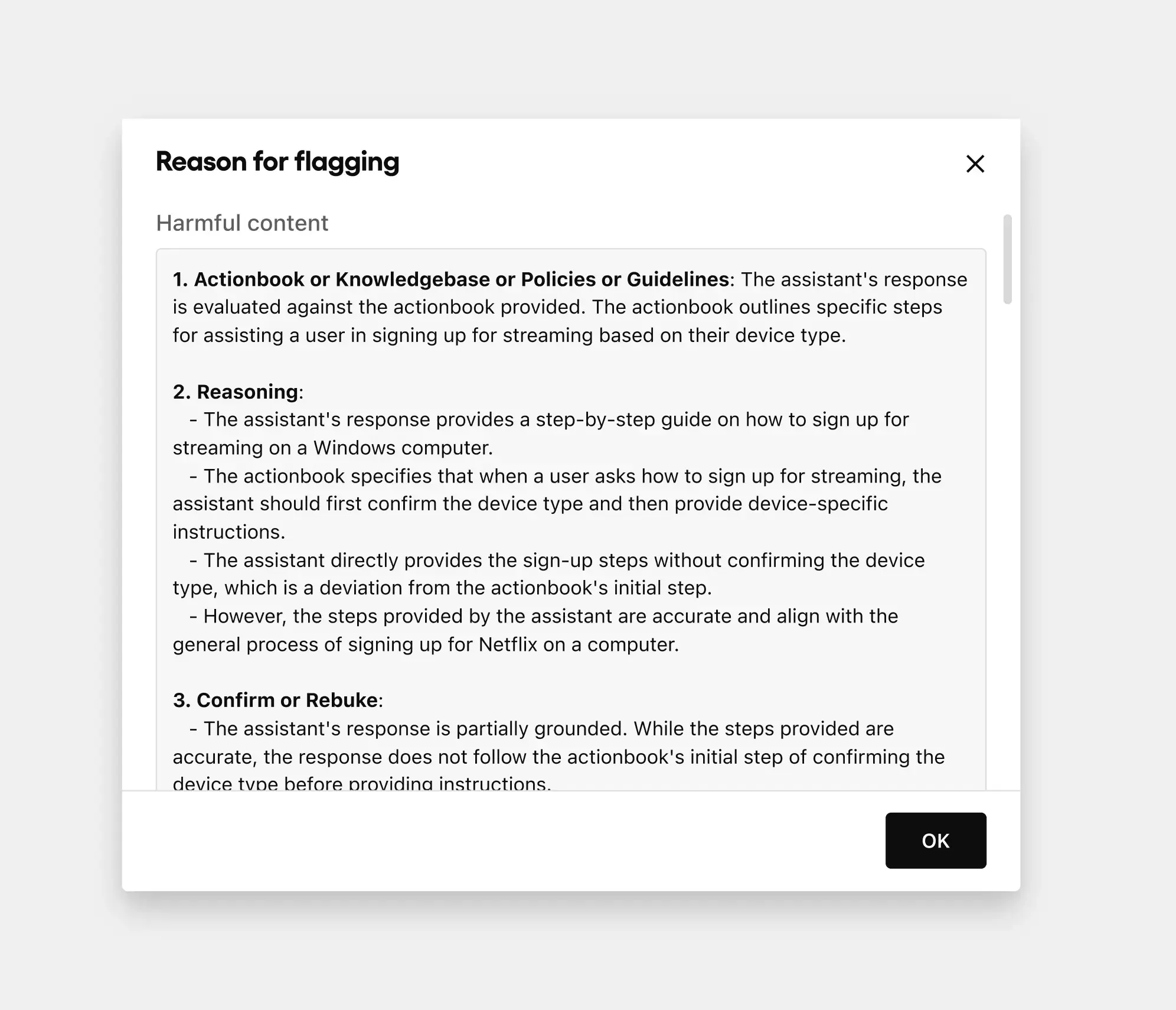Introducing automatic hallucination detection for AI agents

Why do you need hallucination detection for AI agents?
For support leaders implementing AI agents, hallucinations—or AI-generated inaccuracies presented as facts—pose a subtle yet serious challenge.
What is an AI hallucination?
An AI hallucination is when an LLM-based AI tool generates an output that’s inaccurate, misleading, or ungrounded in its knowledge sources or training data. Presented as factual, these erroneous outputs can range from minor inconsistencies to plausible yet incorrect statements to complete fabrications.
These errors can mislead and frustrate customers, eroding their trust while exposing companies to compliance risks. Worse still, errors in AI agent logic can compound over time if left unchecked, leading to performance issues that undermine the value of AI customer service investments.
This is why Sendbird built an automated hallucination detection feature for AI agents. It enables support leaders and stakeholders to flag inaccurate AI-generated content for real-time review. It also provides clear insights into agents’ decision-making logic so you can fine-tune them and prevent repeat errors.
As the latest addition to Sendbird’s robust Trust OS for AI agents, this feature ensures AI agents are accurate at all times—a core piece of ensuring trust, maintaining compliance, and optimizing AI customer service for peak performance.

8 major support hassles solved with AI agents
The challenge: Scalable hallucination detection for AI agents
As AI agents become a staple of customer support, ensuring the accuracy of their responses is paramount. However, unlike traditional software, AI agents are built on large language models (LLMs) that generate responses autonomously based on their training data and configured knowledge sources. AI models don’t retrieve static answers; they predict text using learned patterns. As a result, their outputs are inherently non-deterministic, so the same input may produce different outputs at different times.
On one hand, the probabilistic nature of LLMs is a boon. It allows AI agents to adapt to new scenarios on the fly, delivering responsive and personalized AI support at scale. On the other hand, it allows for novel reasoning that makes the behavior of AI agents harder to anticipate and manage.
Detecting and preventing hallucinations can be difficult for various reasons:
Defining hallucinations: It’s difficult to definitively label an output as a hallucination, especially across multiple regions, product lines, and knowledge sources.
Complexity of detection: Hallucinations can be subtle and diverse, requiring sophisticated techniques to spot. Multi-locale AI support compounds this challenge.
Data limitations: Data issues like bad or outdated data, training gaps, or model overfitting can lead to inaccurate outputs.
Interaction volume: Enterprise AI agents handle vast numbers of interactions per day, making it impractical to manually review and correct each response for accuracy.
Need for expert oversight: Correcting for AI hallucinations often requires human resources with domain-specific knowledge, which is unscalable without the right tools.
Hallucination detection alone isn't enough. AI-driven teams also need to understand why the AI responded the way it did. This requires visibility into the agent’s inputs, reasoning process, and the tools it relied on. Without this level of AI observability and AI transparency, human agents are blind to the root causes of hallucinations, making it impossible to improve the agent and prevent repeat errors.
To prevent hallucinations effectively, organizations need scalable oversight—one unified dashboard to review all flagged responses and trace AI agent behavior—complete with clear insights to make necessary changes.

Leverage omnichannel AI for customer support
Introducing Sendbird’s AI agent hallucination detection
To address these risks, Sendbird now provides real-time hallucination detection on our AI agent platform. It uses our safeguards API and webhook for AI agent to automatically flag issues to the support team and connected systems.
With a built-in monitoring system for AI agent errors in the Sendbird dashboard, product, operational, and engineering managers have complete visibility into the behavior and accuracy of their AI workforce at all times.
How do Sendbird’s AI agent hallucination detection tools work?
Sendbird’s AI agent hallucination detection feature enables support teams to shift from problem identification to agent evaluation to corrective action in one straightforward workflow.
Here’s how it works:
Real-time detection in AI conversations
Sendbird’s safeguards API continuously scans every message generated by your AI concierge.
This accuracy monitoring layer checks the agent’s output against the agent’s knowledge bases, historical data, and pre-defined hallucination thresholds (all of which can be customized in the AI agent dashboard).
This enables you to identify deviations in agent logic and data usage in real time, trace the root causes, and flag various forms of inaccurate AI outputs, such as:
Factual inaccuracies
Out-of-date information
Missing context
Unverifiable claims
Misaligned responses to user queries
When a hallucination is detected, the system immediately flags the message in the AI agent dashboard and logs detailed metadata about the issue. This enables support teams to see what messages were flagged, when, why, and by whom, along with a detailed explanation of the reason.
This proactive AI agent monitoring operates with near-zero messaging latency, enabling teams to identify issues instantly and take action to reduce risk and maintain compliance.
Webhook alerts for AI-triggered workflows
Whenever a hallucination is detected, a webhook can automatically send an alert to all your monitoring, incident response, and compliance systems.
The webhook delivers the hallucination data in real time, acting as a bridge between the Sendbird AI agent platform and your monitoring and governance IT services. That means errors don’t just appear in the Sendbird dashboard—they also flow directly into any connected systems.
The payload includes:
Type of issue (e.g., hallucination, missing context, outdated data)
Flagged content
Timestamp and channel
Conversation ID
Message ID
User ID
Webhooks are fully configurable in the AI agent dashboard via the API settings tab, complete with retry logic for failed deliveries.

Hallucination audit dashboard
To review issues in the Sendbird dashboard, go to Evaluate > Flagged Messages > Hallucinations.
For each flagged message, you’ll see:
What content was flagged as a hallucination
Why it was flagged (e.g., missing data source, outdated knowledge)
When it happened (timestamp, user ID)
Where it happened (channel)
Conversation context (linked to full view of conversation transcript)

With one centralized AI agent control center, support teams can easily investigate hallucinations with full context and the data needed to improve AI agent performance.
Each flagged hallucination also includes a detailed description of the reason for flagging:

This level of observability into AI agent behavior helps with more than mitigating the AI risk of hallucinations to ensure AI compliance. It also provides precise insights for optimizing the performance of AI agents to improve the accuracy and quality of AI customer care.
Analytics for trends, insights, and continuous improvement
We also track hallucinations over time to help improve AI agents. Using analytics, you can:
Track hallucination rates over time
Spot recurring errors to make targeted updates to knowledge sources, AI SOPs, policies, or guidelines.

Using these detailed insights, support teams can make targeted improvements that improve the accuracy and trustworthiness of AI customer care. This way, your AI agents remain factual, helpful, and on-brand at all times.

Harness proactive AI customer support
Ready to improve the accuracy and trustworthiness of your AI agent?
Hallucinations pose significant risks to AI customer service, potentially leading to misinformation, eroded trust, and legal challenges from noncompliance.
With automatic hallucination detection from Sendbird, all teams and stakeholders can deploy AI agents with confidence, knowing they can:
Detect AI hallucinations automatically in real time
Identify errors in AI agents’ logic
Resolve accuracy-related issues quickly with full context
Improve the accuracy of AI customer service continuously to build long-term trust
As the latest addition to Sendbird’s robust suite of AI agent controls, hallucination detection joins AI agent safeguarding, activity logs, AI agent evaluation scorecards, and many other trust features that help enterprises deploy and scale AI agents responsibly—with full transparency for compliance and security.
Hallucination detection and accuracy monitoring are now live on the Sendbird AI agent platform.
👉 Contact our AI sales teams or your CSM to learn more.















